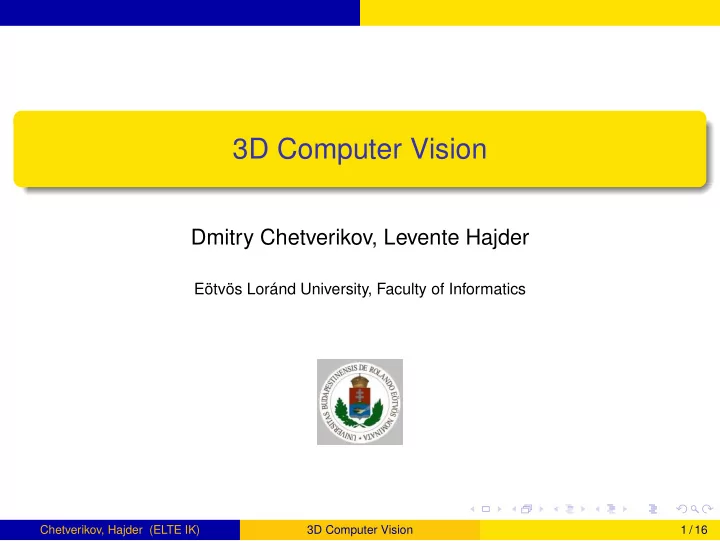

3D Computer Vision Dmitry Chetverikov, Levente Hajder Eötvös Loránd University, Faculty of Informatics Chetverikov, Hajder (ELTE IK) 3D Computer Vision 1 / 16
Reconstruction by Special Devices Outline 1 Laser scanning 2 Structured-light scanning 3 Depth cameras + LiDAR 4 Chetverikov, Hajder (ELTE IK) 3D Computer Vision 2 / 16
Outline Outline Outline 1 Laser scanning 2 Structured-light scanning 3 Depth cameras + LiDAR 4 Chetverikov, Hajder (ELTE IK) 3D Computer Vision 3 / 16
Outline Outline Motivation: Objects can be scanned by the help of artificial illumination More accurate reconstruction can be obtained. Bottleneck of standard camera-based vision: correspondences between images. Illumination can help correspondence detection. Weak-point: usually, good illumination requires indoor environment (laboratory) Existing solutions: Laser-scanning Structured-light scanning Depth cameras Outdoor depth cameras exist. etc. Chetverikov, Hajder (ELTE IK) 3D Computer Vision 4 / 16
Laser scanning Outline Outline 1 Laser scanning 2 Structured-light scanning 3 Depth cameras + LiDAR 4 Chetverikov, Hajder (ELTE IK) 3D Computer Vision 5 / 16
Laser scanning Laser scanning Equipment: camera + laser stripe illuminator. Camera and laser must be fixed to each other. Calibration is required. Chessboard-based calibration by switching the laser on/off. Location of laser stripe can be determined in the plane of the chessboard. Plane of illumination can be determined from at least two chessboards. More than two chessboards: plane estimation in 3D is overdetermined. Reconstruction: A laser point determines a ray by back-projection. Spatial point: intersection of the laser plane and the back-projected ray. Chetverikov, Hajder (ELTE IK) 3D Computer Vision 6 / 16
Laser scanning Laser scanning: calibration Calibration by chessboard Camera intrinsic parameters are known. Chessboard illuminated by the laser stripe. Image and spatial chessboard positions can be transformed into each other by a homography. Line of the laser stripe in 3D: points transformed by the inverse of the homography. More lines: they are in the same 3D plane. Plane fitting to spatial lines Lines sampled as points → plane fitting possible from at least two lines Plane point p 0 : center of gravity → Let origin be p 0 . Normal and tangent directions v 1 and v 2 can be determined by Principal Component Analysis (PCA) PCA is obtained by Singular Value Decomposition. Chetverikov, Hajder (ELTE IK) 3D Computer Vision 7 / 16
Laser scanning Laser scanning: 3D Reconstruction Pixels corresponding to laser stripes can be detected in images. A projective ray can be determined by back-projecting the pixel using camera parameters. Ray can be written e.g. parametric form: q 0 + t w , where t is the parameter of the line. q 0 : focal point w : direction of the ray Spatial point: intersection of projecting ray and plane of the laser. q 0 + t w = p 0 + a v 1 + b v 2 Three linear equations as each coordinate serves one equation Unknown parameters are t , a , and b . Solution: obtained parameters substituted into left or right side of the linear equation. Chetverikov, Hajder (ELTE IK) 3D Computer Vision 8 / 16
Structured-light scanning Outline Outline 1 Laser scanning 2 Structured-light scanning 3 Depth cameras + LiDAR 4 Chetverikov, Hajder (ELTE IK) 3D Computer Vision 9 / 16
Structured-light scanning Structured-light scanning Special patterns are projected onto object surface. Standard projector can be applied. Non-visible, e.g. infra, light can be used. Camera and projector have to be fixed to each other. Calibration is required. Chessboard can be illuminated by the projector. Projector equals to an inverse camera: it illuminates and not projects. If chessboard pose known in 3D, pattern positions can be computed by a homography. Key-question: what kind of pattern is illuminated? Chetverikov, Hajder (ELTE IK) 3D Computer Vision 10 / 16
Structured-light scanning Structured-light scanning Goal of pattern: to help the detection of corresponding points Vertical and horizontal striped are illuminated, different stripe thickness applied Striped encodes row/column numbers of projector pixels Trivial, binary coding: n-th bits of column/row number yields color in n-th illumination Correction codes can also be applied to improve reliability. Chetverikov, Hajder (ELTE IK) 3D Computer Vision 11 / 16
Structured-light scanning Structured-light scanning It is assumed that Cameras are calibrated (using e.g. chessboard) 1 Projector is calibrated (chessboard + illumination) 2 Camera-projector correspondence can be detected by coding 3 Only bright/dark pixels have to be separated Spatial reconstruction: by stereo triangulation Chetverikov, Hajder (ELTE IK) 3D Computer Vision 12 / 16
Structured-light scanning Modified structured-light scanning Other patterns can be illuminated. Finer resolution, more images Phase shifting of the laser light can be applied. Reconstruction from a single image is also possible Dots can also be used as patterns Microsoft Kinect Infra projector + camera Depth image is computed by the device Depth image + color : RGB-D camera Chetverikov, Hajder (ELTE IK) 3D Computer Vision 13 / 16
Depth cameras + LiDAR Outline Outline 1 Laser scanning 2 Structured-light scanning 3 Depth cameras + LiDAR 4 Chetverikov, Hajder (ELTE IK) 3D Computer Vision 14 / 16
Depth cameras + LiDAR Depth camera A flash emits light, usually infra-red light applied. Camera detects light. Time of flight (TOF) between emittance and detection is measured. These cameras are also called ToF cameras. Speed of light known, distance can be calculated. Output: depth image, small resolution. Rapid circuits required. Depth granulation is quire small (approx. centimeter) Chetverikov, Hajder (ELTE IK) 3D Computer Vision 15 / 16
Depth cameras + LiDAR LIDAR: Light Detection and Ranging Spacial depth camera. Camera is rotating, 360 degree scanning is possible. Frequently used in autonomous vehicles. Car (e.g. Google Street View) Trucks (Knorr Bremse) Airplanes Output: sparse point cloud. Chetverikov, Hajder (ELTE IK) 3D Computer Vision 16 / 16
Recommend
More recommend